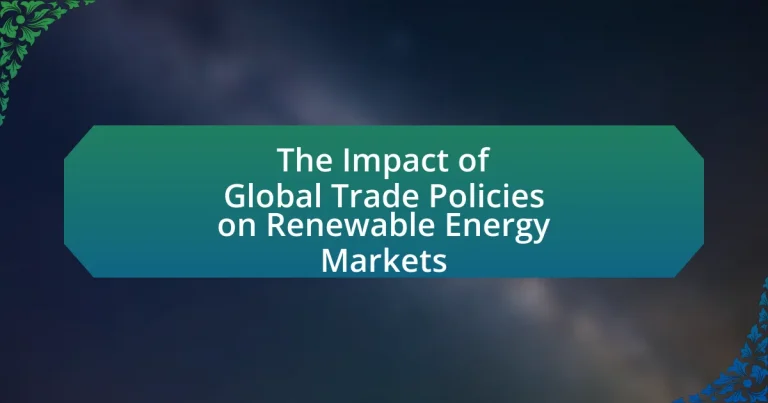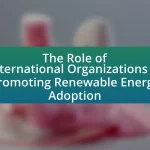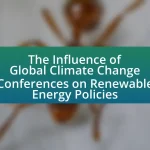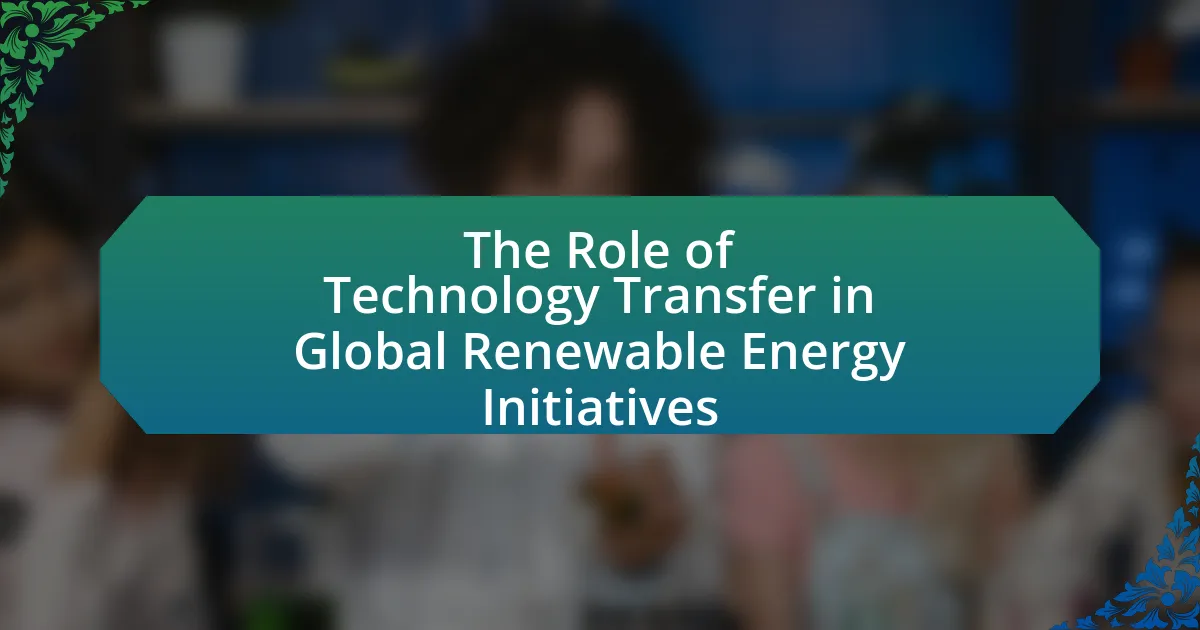Global trade policies are critical regulations and agreements that shape international trade dynamics, significantly influencing renewable energy markets. These policies can either facilitate or obstruct the flow of renewable technologies, such as solar panels and wind turbines, through mechanisms like tariffs and subsidies. The article examines how trade agreements, such as the Paris Agreement and the USMCA, impact market access, investment flows, and technology transfer in the renewable energy sector. It also highlights the effects of tariffs and trade barriers on costs and competitiveness, the role of subsidies in shaping market dynamics, and best practices for stakeholders to navigate these policies effectively. Overall, the discussion underscores the importance of aligning trade policies with renewable energy goals to foster sustainable economic growth and environmental sustainability.
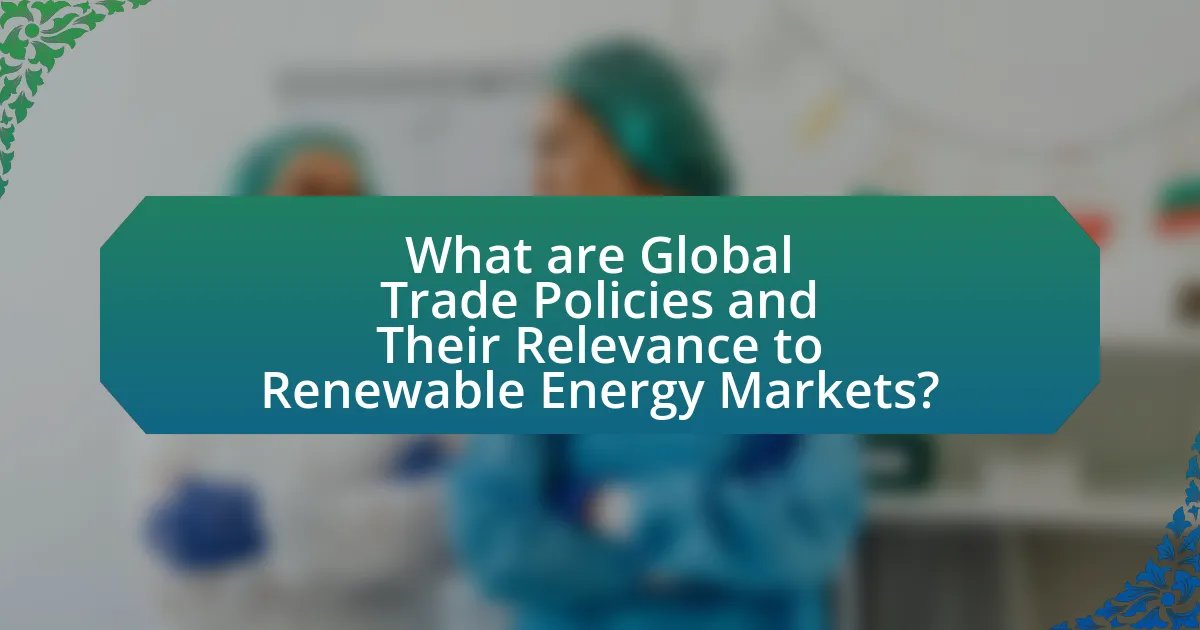
What are Global Trade Policies and Their Relevance to Renewable Energy Markets?
Global trade policies are regulations and agreements that govern international trade between countries, significantly impacting renewable energy markets. These policies can facilitate or hinder the flow of renewable energy technologies, such as solar panels and wind turbines, by imposing tariffs, quotas, or subsidies. For instance, the World Trade Organization (WTO) agreements aim to reduce trade barriers, which can enhance market access for renewable energy products, thereby promoting their adoption. Additionally, trade policies that support clean energy initiatives, like the European Union’s Green Deal, can drive investments in renewable energy sectors, fostering innovation and competitiveness.
How do global trade policies influence the renewable energy sector?
Global trade policies significantly influence the renewable energy sector by shaping market access, investment flows, and technology transfer. For instance, tariffs on imported solar panels can increase costs for domestic solar energy projects, thereby slowing down the adoption of solar technology. According to the International Renewable Energy Agency (IRENA), trade barriers can lead to a 20% increase in the cost of renewable energy technologies, which directly impacts their competitiveness against fossil fuels. Additionally, trade agreements that promote cooperation in renewable energy can facilitate the sharing of best practices and innovations, enhancing overall sector growth.
What specific trade agreements impact renewable energy markets?
Specific trade agreements that impact renewable energy markets include the Paris Agreement, the United States-Mexico-Canada Agreement (USMCA), and the European Union’s trade agreements with various countries. The Paris Agreement, adopted in 2015, sets international climate goals that encourage countries to transition to renewable energy sources, thereby influencing market dynamics globally. The USMCA includes provisions that promote clean energy technologies and facilitate trade in renewable energy products among the member countries. Additionally, the European Union has established trade agreements that prioritize sustainable development and renewable energy cooperation, impacting market access and investment in renewable technologies across member states and partner countries.
How do tariffs and trade barriers affect renewable energy technologies?
Tariffs and trade barriers significantly hinder the growth and adoption of renewable energy technologies by increasing costs and limiting market access. For instance, tariffs on solar panels and wind turbines can raise prices for consumers and developers, slowing down investment in these technologies. According to a report by the International Renewable Energy Agency (IRENA), the imposition of tariffs can lead to a 20-30% increase in the cost of solar energy projects, which directly impacts their competitiveness against fossil fuels. Additionally, trade barriers can restrict the import of essential components, leading to supply chain disruptions and delays in project implementation. This creates an unfavorable environment for innovation and scaling up renewable energy solutions, ultimately affecting global efforts to transition to a sustainable energy future.
Why are renewable energy markets important in the context of global trade?
Renewable energy markets are crucial in the context of global trade because they facilitate the transition to sustainable energy sources, which is essential for addressing climate change and reducing dependency on fossil fuels. The growth of these markets promotes international collaboration, as countries engage in the exchange of technology, resources, and expertise to develop renewable energy solutions. For instance, the International Renewable Energy Agency reported that global renewable energy capacity reached 2,799 gigawatts in 2020, highlighting the increasing investment and trade in this sector. Additionally, trade policies that support renewable energy can enhance energy security and create economic opportunities, as seen in the European Union’s Green Deal, which aims to make Europe climate-neutral by 2050 through investments in renewable technologies.
What role do renewable energy markets play in global economic growth?
Renewable energy markets significantly contribute to global economic growth by driving investment, creating jobs, and fostering technological innovation. In 2020, the renewable energy sector attracted over $300 billion in investments, highlighting its role as a key driver of economic activity. Additionally, the International Renewable Energy Agency reported that the sector employed 11.5 million people worldwide in 2018, demonstrating its capacity to generate employment opportunities. Furthermore, advancements in renewable technologies, such as solar and wind, have led to cost reductions, making energy more accessible and stimulating further economic development. These factors collectively underscore the essential role of renewable energy markets in enhancing global economic growth.
How do renewable energy markets contribute to environmental sustainability?
Renewable energy markets contribute to environmental sustainability by reducing greenhouse gas emissions and promoting cleaner energy sources. The transition from fossil fuels to renewable energy, such as solar, wind, and hydroelectric power, significantly lowers carbon dioxide emissions, which are a major contributor to climate change. For instance, a report by the International Renewable Energy Agency (IRENA) indicates that doubling the share of renewable energy in the global energy mix could reduce greenhouse gas emissions by up to 70% by 2050. Additionally, renewable energy markets foster biodiversity by minimizing habitat destruction associated with fossil fuel extraction and combustion. This shift not only mitigates environmental degradation but also enhances energy security and resilience against climate-related disruptions.
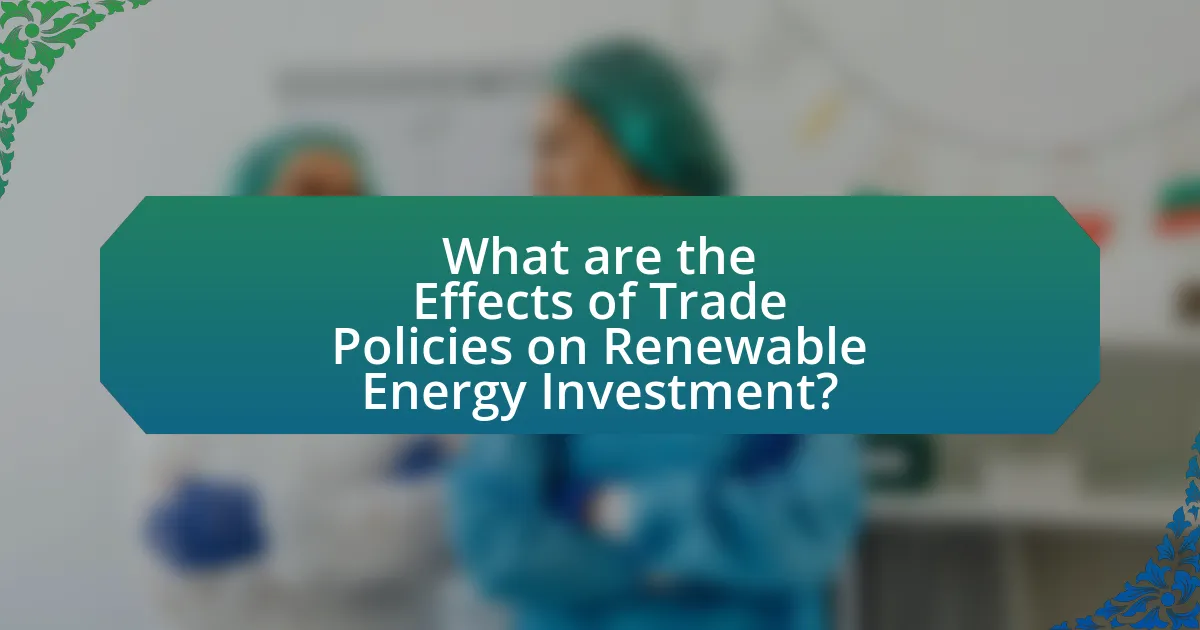
What are the Effects of Trade Policies on Renewable Energy Investment?
Trade policies significantly influence renewable energy investment by shaping market access, costs, and competitiveness. For instance, tariffs on imported solar panels can increase costs for domestic developers, thereby reducing investment in solar energy projects. According to a report by the International Renewable Energy Agency (IRENA), countries that implement supportive trade policies, such as reducing tariffs and promoting technology transfer, tend to attract higher levels of investment in renewable energy. Additionally, trade agreements that include provisions for renewable energy can facilitate cross-border investments, enhancing the overall growth of the sector.
How do trade policies affect foreign direct investment in renewable energy?
Trade policies significantly influence foreign direct investment (FDI) in renewable energy by shaping market access, regulatory frameworks, and investment incentives. For instance, countries that implement favorable trade policies, such as reduced tariffs on renewable energy technologies, attract more FDI by lowering costs for foreign investors. According to the International Renewable Energy Agency (IRENA), nations with supportive trade policies saw a 30% increase in FDI in renewable sectors between 2015 and 2020. Conversely, protectionist trade measures can deter investment by creating barriers, leading to a decline in FDI as seen in countries that imposed tariffs on solar panels, which resulted in a 20% drop in investment in the solar sector. Thus, the alignment of trade policies with renewable energy goals is crucial for attracting and sustaining foreign direct investment in this sector.
What are the implications of investment restrictions on renewable energy projects?
Investment restrictions on renewable energy projects hinder capital flow, stifle innovation, and delay project implementation. These restrictions can lead to reduced competitiveness in the global market, as countries with fewer barriers attract more investment. For instance, according to the International Renewable Energy Agency (IRENA), countries that maintain open investment policies have seen a 30% increase in renewable energy capacity compared to those with restrictive measures. Additionally, investment limitations can result in higher costs for technology and materials, ultimately impacting the affordability of renewable energy solutions.
How do trade policies influence investor confidence in renewable energy markets?
Trade policies significantly influence investor confidence in renewable energy markets by establishing a regulatory framework that can either encourage or deter investment. For instance, favorable trade policies, such as reduced tariffs on renewable energy technologies, can lower costs for investors, thereby increasing their willingness to invest. According to a report by the International Renewable Energy Agency (IRENA), countries that implemented supportive trade policies saw a 30% increase in foreign direct investment in renewable energy sectors. Conversely, restrictive trade policies can create uncertainty and increase operational costs, leading to decreased investor confidence. For example, the imposition of tariffs on solar panels in the United States in 2018 resulted in a slowdown of investment in solar energy projects, as reported by the Solar Energy Industries Association. Thus, the nature of trade policies directly correlates with the level of investor confidence in renewable energy markets.
What are the impacts of trade policies on technology transfer in renewable energy?
Trade policies significantly influence technology transfer in renewable energy by either facilitating or hindering the exchange of innovative technologies across borders. For instance, tariffs on imported renewable energy technologies can increase costs for domestic companies, discouraging investment in new technologies and slowing down the adoption of renewable energy solutions. Conversely, trade agreements that promote collaboration and reduce barriers can enhance technology transfer, as seen in the European Union’s efforts to harmonize standards for renewable energy technologies, which has led to increased sharing of innovations among member states. Additionally, countries that implement supportive trade policies often experience accelerated growth in their renewable energy sectors, as evidenced by China’s rise as a leader in solar technology, driven by favorable trade conditions and government support.
How do trade agreements facilitate or hinder technology sharing?
Trade agreements facilitate technology sharing by establishing frameworks that promote collaboration and reduce barriers to the exchange of innovations. For instance, agreements like the United States-Mexico-Canada Agreement (USMCA) include provisions that encourage joint research and development initiatives, thereby enhancing the transfer of renewable energy technologies among member countries. Conversely, trade agreements can hinder technology sharing when they impose strict intellectual property protections that limit access to essential technologies. An example is the Trade-Related Aspects of Intellectual Property Rights (TRIPS) agreement, which can restrict the ability of developing nations to utilize advanced technologies for renewable energy solutions.
What are the consequences of limited technology access for renewable energy development?
Limited technology access significantly hinders renewable energy development by restricting innovation, efficiency, and scalability. When countries or regions lack access to advanced technologies, they struggle to implement effective renewable energy solutions, resulting in slower adoption rates and increased reliance on fossil fuels. For instance, according to the International Renewable Energy Agency (IRENA), nations with limited technological capabilities often miss out on cost reductions associated with renewable technologies, which can be as high as 80% for solar photovoltaic systems over the past decade. This technological gap not only stifles local industry growth but also perpetuates energy poverty, as communities remain dependent on outdated energy sources.

How Do Global Trade Policies Shape Renewable Energy Market Dynamics?
Global trade policies significantly influence renewable energy market dynamics by determining tariffs, subsidies, and trade agreements that affect the cost and availability of renewable technologies. For instance, the imposition of tariffs on solar panels by the United States in 2018 led to increased prices for solar energy systems, which slowed down market growth and investment in solar projects. Conversely, trade agreements that promote the exchange of renewable energy technologies can enhance market access and reduce costs, fostering innovation and expansion in the sector. The World Trade Organization (WTO) has also emphasized the importance of reducing trade barriers to support the global transition to renewable energy, highlighting that such policies can facilitate the deployment of clean technologies and drive down prices through increased competition.
What are the competitive advantages created by trade policies in renewable energy?
Trade policies in renewable energy create competitive advantages by promoting market access, reducing tariffs, and incentivizing investment in clean technologies. These policies facilitate the entry of renewable energy products into new markets, allowing companies to expand their reach and increase sales. For instance, the World Trade Organization reported that countries implementing lower tariffs on solar panels and wind turbines have seen a significant increase in imports, leading to a more competitive market landscape. Additionally, trade policies often include subsidies and tax incentives for domestic producers, which can lower production costs and enhance competitiveness against foreign imports. This strategic support fosters innovation and efficiency within the renewable energy sector, ultimately driving down prices for consumers and accelerating the transition to sustainable energy sources.
How do trade policies affect pricing and market access for renewable energy products?
Trade policies significantly influence pricing and market access for renewable energy products by imposing tariffs, quotas, and regulations that can either facilitate or hinder international trade. For instance, high tariffs on imported solar panels can increase their prices in domestic markets, making them less competitive compared to fossil fuels. Conversely, subsidies for domestic renewable energy production can lower prices and enhance market access for local products. According to the International Renewable Energy Agency (IRENA), countries that implement favorable trade policies, such as reduced tariffs and supportive regulations, experience accelerated growth in renewable energy markets, evidenced by a 20% increase in solar capacity in nations that adopted such measures between 2015 and 2020.
What role do subsidies play in shaping market dynamics under trade policies?
Subsidies play a crucial role in shaping market dynamics under trade policies by influencing production costs and consumer prices. They enable domestic industries to compete against foreign imports by lowering the effective price of goods, which can lead to increased market share for local producers. For instance, in the renewable energy sector, countries like Germany and China have implemented substantial subsidies for solar energy, resulting in significant growth in domestic production and a decrease in prices globally. This has led to a shift in market dynamics, where subsidized industries can outcompete non-subsidized ones, affecting international trade flows and investment patterns.
How do trade policies impact the supply chain of renewable energy resources?
Trade policies significantly impact the supply chain of renewable energy resources by influencing tariffs, import/export regulations, and market access. For instance, high tariffs on solar panels can increase costs for manufacturers and consumers, thereby slowing down the adoption of solar energy technologies. According to the International Renewable Energy Agency (IRENA), trade barriers can lead to a 20-30% increase in the cost of renewable energy projects, which directly affects investment and development in the sector. Additionally, favorable trade agreements can facilitate the flow of materials and technologies necessary for renewable energy production, enhancing supply chain efficiency and reducing costs.
What are the effects of trade restrictions on the availability of renewable energy materials?
Trade restrictions significantly reduce the availability of renewable energy materials by limiting imports and exports of essential components. For instance, tariffs on solar panels and wind turbine parts can increase costs for manufacturers, leading to higher prices for consumers and reduced investment in renewable energy projects. According to a report by the International Renewable Energy Agency (IRENA), trade barriers can disrupt supply chains, causing delays in project implementation and hindering the growth of renewable energy sectors. Additionally, countries that impose restrictions may face retaliatory measures, further complicating access to critical materials needed for renewable energy technologies.
How do global supply chain disruptions influence renewable energy markets?
Global supply chain disruptions negatively impact renewable energy markets by causing delays in the production and delivery of essential components, such as solar panels and wind turbines. For instance, the COVID-19 pandemic led to significant shortages of semiconductor chips, which are crucial for renewable energy technologies, resulting in project delays and increased costs. According to a report by the International Renewable Energy Agency (IRENA), supply chain issues can lead to a 20-30% increase in project costs and a slowdown in the deployment of renewable energy projects. These disruptions can hinder the transition to cleaner energy sources, affecting global climate goals and energy security.
What best practices can stakeholders adopt to navigate trade policies in renewable energy?
Stakeholders can adopt several best practices to navigate trade policies in renewable energy, including staying informed about policy changes, engaging in advocacy, and collaborating with industry peers. Staying informed allows stakeholders to anticipate shifts in regulations and tariffs that could impact their operations; for instance, the International Renewable Energy Agency (IRENA) regularly publishes reports on global trade trends that can guide decision-making. Engaging in advocacy helps stakeholders influence policy development by participating in consultations and forming coalitions to represent their interests effectively. Collaboration with industry peers fosters knowledge sharing and collective action, which can strengthen their position in negotiations and enhance compliance with trade regulations. These practices are essential for adapting to the dynamic landscape of renewable energy trade policies.
